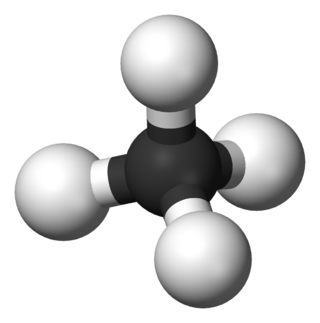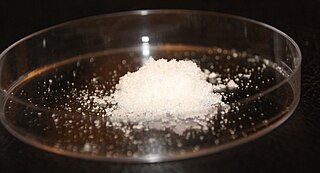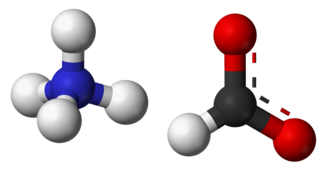
Brasso is a metal polish designed to remove tarnish from brass, copper, chrome and stainless steel. It is available either directly as a liquid or as an impregnated wadding pad also known as Duraglit.

Brasso is a metal polish designed to remove tarnish from brass, copper, chrome and stainless steel. It is available either directly as a liquid or as an impregnated wadding pad also known as Duraglit.
Brasso originated in Britain in about 1905. Reckitt & Sons' senior traveller, W. H. Slack, visited the company's Australian branch, where he discovered such a product in use. Samples from Australian and US producers were then analysed by Reckitt's chemists, and by 1920 liquid polish under the trademark "Brasso" was being sold, initially to railways, hospitals, hotels, and large shops. [1]
Because of the hydrocarbon components in the mixture it had a flash point of 72 °F (22 °C) (Abel Close test) and so was classed by railway companies as dangerous goods. This classification allowed the railway companies to charge more for distributing Brasso around the country. Reckitt's appealed to the companies asking for the polish to be recategorized in the hope of reducing costs, but the railways disagreed. As a result of this in 1913 the case was taken to the Railway and Canal Commissioners for a decision. After a hearing lasting two days the commissioners decided in favour of the railway companies, and Brasso remained classed as a dangerous substance for the purposes of railway transport. [2] [3]
The polish grew in popularity in Britain, becoming widely available, eventually replacing the previous paste-style polishes. It has undergone very few changes in either composition or package design over the past century. Cans are often collected as a typical example of classic British advertising design.
In the US, the current Brasso product is not the same as the legacy product. The manufacturer, Reckitt Benckiser, has not produced the impregnated wadding version of the product for many years. The formula changed in 2008 to comply with US volatile organic compounds law, and the metal bottle was replaced by a plastic one.
In 2010, Brasso brought out a new product, Brasso Gadgetcare. Gadgetcare is a versatile, non-abrasive gel that can be used on everything from LCD TV screens, laptop screens, computers, smart phones, and PDAs. The plastic bottle is 50ml and is sold with a microfibre cloth.
The label of Australian Brasso lists "Liquid Hydrocarbons 630g/L; Ammonia 7g/L", whereas the material safety data sheet for Brasso in North America lists: isopropyl alcohol 3–5%, ammonia 5–10%, silica powder 15–20% and oxalic acid 0–3% as the ingredients. [4] The Australian version also contains silica (silicon dioxide) for abrasives. [5]
The online data sheet for Brasso wadding in the UK lists the ingredients as C8–10 Alkane/Cycloalkane/Aromatic Hydrocarbons, Quartz, C14–18 and C16–18 unsaturated Fatty acids, Kaolinite, Aqua, Ammonium Hydroxide and Iron Hydroxide. Brasso liquid lists a slightly different mix; C8–10 Alkane/Cycloalkane/Aromatic Hydrocarbons, Quartz, Kaolin, C12–20 Saturated and Unsaturated Monobasic Fatty Acids, Aqua and Ammonium Hydroxide. Also available are ingredients in a discontinued recipe for Brasso. Wadding: C8–10 Alkane/Cycloalkane/Aromatic Hydrocarbons, Quartz, Ammonium Tallate and Colorant. Liquid: C8–10 Alkane/Cycloalkane/Aromatic Hydrocarbons, Quartz, Kaolin and Ammonium Tallate. [6]
Brasso is abrasive and will wear metal over time. The National Trust recommend alternative cleaners. [7]
Brasso has also been used to polish out scratches in plastics:
Brasso has been successfully used to take minor (white) heat marks out of French polished wooden surfaces. The fine abrasive cuts through the surface and allows the solvent into the wax and lacquer layer. The surface should be properly cleaned and waxed after this treatment.
Brasso has been successfully used to restore Bakelite (telephones, appliances, etc.).
Brasso, on account of its ammonia content, has been used as a de-coppering agent in rifle barrels to remove copper fouling.

In organic chemistry, an alkane, or paraffin, is an acyclic saturated hydrocarbon. In other words, an alkane consists of hydrogen and carbon atoms arranged in a tree structure in which all the carbon–carbon bonds are single. Alkanes have the general chemical formula CnH2n+2. The alkanes range in complexity from the simplest case of methane, where n = 1, to arbitrarily large and complex molecules, like pentacontane or 6-ethyl-2-methyl-5-(1-methylethyl) octane, an isomer of tetradecane.

Ammonia is an inorganic chemical compound of nitrogen and hydrogen with the formula NH3. A stable binary hydride and the simplest pnictogen hydride, ammonia is a colourless gas with a distinctive pungent smell. Biologically, it is a common nitrogenous waste, and it contributes significantly to the nutritional needs of terrestrial organisms by serving as a precursor to fertilisers. Around 70% of ammonia produced industrially is used to make fertilisers in various forms and composition, such as urea and diammonium phosphate. Ammonia in pure form is also applied directly into the soil.

In organic chemistry, a hydrocarbon is an organic compound consisting entirely of hydrogen and carbon. Hydrocarbons are examples of group 14 hydrides. Hydrocarbons are generally colourless and hydrophobic; their odor is usually faint, and may be similar to that of gasoline or lighter fluid. They occur in a diverse range of molecular structures and phases: they can be gases, liquids, low melting solids or polymers.

Windex is an American brand of glass and hard-surface cleaners—originally in glass containers, later in plastic ones.

K-Y Jelly is a water-based, water-soluble personal lubricant, most commonly used as a lubricant for sexual intercourse and masturbation. A variety of different products and formulas are produced under the K-Y banner, some of which are not water-soluble.

In organic chemistry, the cycloalkanes are the monocyclic saturated hydrocarbons. In other words, a cycloalkane consists only of hydrogen and carbon atoms arranged in a structure containing a single ring, and all of the carbon-carbon bonds are single. The larger cycloalkanes, with more than 20 carbon atoms are typically called cycloparaffins. All cycloalkanes are isomers of alkenes.
Ammonia solution, also known as ammonia water, ammonium hydroxide, ammoniacal liquor, ammonia liquor, aqua ammonia, aqueous ammonia, or (inaccurately) ammonia, is a solution of ammonia in water. It can be denoted by the symbols NH3(aq). Although the name ammonium hydroxide suggests a salt with the composition [NH+
4][OH−
], it is actually impossible to isolate samples of NH4OH. The ions NH+
4 and OH− do not account for a significant fraction of the total amount of ammonia except in extremely dilute solutions.

Nonane is a linear alkane hydrocarbon with the chemical formula C9H20. It is a colorless, flammable liquid, occurring primarily in the component of the petroleum distillate fraction commonly called kerosene, which is used as a heating, tractor, and jet fuel. Nonane is also used as a solvent, distillation chaser, fuel additive, and a component in biodegradable detergents.
Cyclopentane (also called C pentane) is a highly flammable alicyclic hydrocarbon with chemical formula C5H10 and CAS number 287-92-3, consisting of a ring of five carbon atoms each bonded with two hydrogen atoms above and below the plane. It occurs as a colorless liquid with a petrol-like odor. Its freezing point is −94 °C and its boiling point is 49 °C. Cyclopentane is in the class of cycloalkanes, being alkanes that have one or more carbon rings. It is formed by cracking cyclohexane in the presence of alumina at a high temperature and pressure.

Sulfamic acid, also known as amidosulfonic acid, amidosulfuric acid, aminosulfonic acid, sulphamic acid and sulfamidic acid, is a molecular compound with the formula H3NSO3. This colourless, water-soluble compound finds many applications. Sulfamic acid melts at 205 °C before decomposing at higher temperatures to water, sulfur trioxide, sulfur dioxide and nitrogen.
Higher alkanes are alkanes having nine or more carbon atoms. Nonane is the lightest alkane to have a flash point above 25 °C, and is not classified as dangerously flammable.
Sugar soap, as typically found in Commonwealth countries, is a cleaning material of variable composition sold for use on surfaces affected by greasy or tarry deposits which are not easily removed with routine domestic cleaning materials. Its name arises from the fact that, when in dry powder form, it resembles table sugar.

Hydrodesulfurization (HDS), also called hydrotreatment or hydrotreating, is a catalytic chemical process widely used to remove sulfur (S) from natural gas and from refined petroleum products, such as gasoline or petrol, jet fuel, kerosene, diesel fuel, and fuel oils. The purpose of removing the sulfur, and creating products such as ultra-low-sulfur diesel, is to reduce the sulfur dioxide emissions that result from using those fuels in automotive vehicles, aircraft, railroad locomotives, ships, gas or oil burning power plants, residential and industrial furnaces, and other forms of fuel combustion.

Lysol is a brand of American cleaning and disinfecting products distributed by Reckitt, which markets the similar Dettol or Sagrotan in other markets. The line includes liquid solutions for hard and soft surfaces, air treatment, and hand washing. The active ingredient in many Lysol products is benzalkonium chloride, but the active ingredient in the Lysol "Power and Free" line is hydrogen peroxide. Lysol has been used since its invention in the late 19th century as a household and industrial cleaning agent, and previously as a medical disinfectant.
Harpic is the brand name of a toilet cleaner launched in the United Kingdom in 1932 by Reckitt and Sons. It is currently available in Africa, the Middle East, South Asia, the Asia-Pacific, Europe, and the Americas. The toilet cleaning products marketed under the brand name include liquids, tablets, wipes, brush systems, toilet rim blocks, and in-cistern blocks.

Ammonium formate, NH4HCO2, is the ammonium salt of formic acid. It is a colorless, hygroscopic, crystalline solid.

Cleaning agents or hard-surface cleaners are substances used to remove dirt, including dust, stains, foul odors, and clutter on surfaces. Purposes of cleaning agents include health, beauty, removing offensive odor, and avoiding the spread of dirt and contaminants to oneself and others. Some cleaning agents can kill bacteria and clean at the same time. Others, called degreasers, contain organic solvents to help dissolve oils and fats.

Ammonium sulfite is the ammonium salt of sulfurous acid with the chemical formula (NH4)2SO3.
Reckitt and Sons was a leading British manufacturer of household products, notably starch, black lead, laundry blue, and household polish, and based in Kingston upon Hull.

2,3-Dimethylpentane is an organic compound of carbon and hydrogen with formula C
7H
16, more precisely CH
3–CH(CH
3)–CH(CH
3)–CH
2–CH
3: a molecule of pentane with methyl groups –CH
3 replacing hydrogen atoms on carbon atoms 2 and 3. It is an alkane, a fully saturated hydrocarbon; specifically, one of the isomers of heptane.